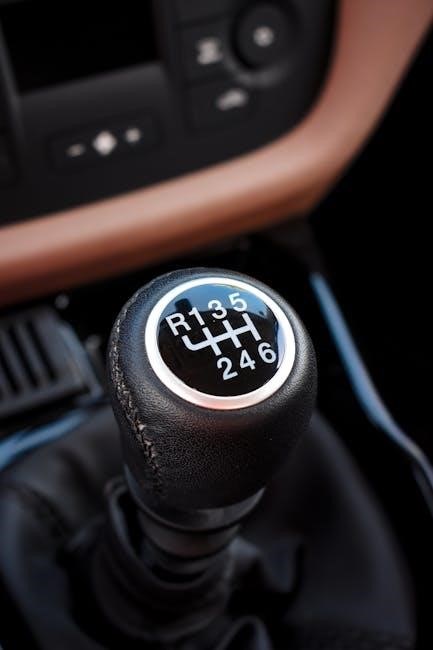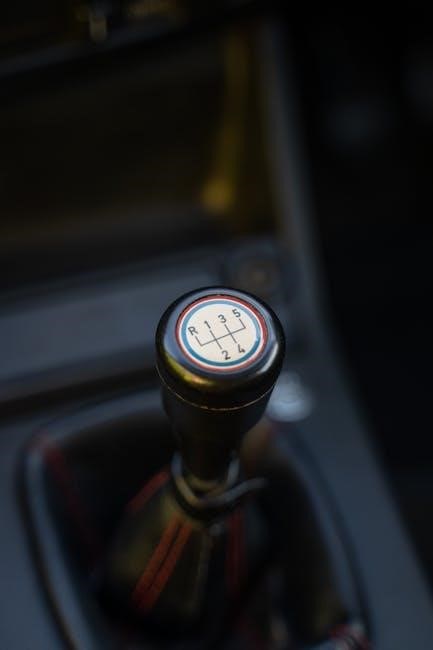A manual transmission in an ATV allows riders to control gear shifts, offering better performance and efficiency. Common in sport models, it requires skill and engagement, enhancing the riding experience.
1.1 Overview of Manual Transmission in ATVs
A manual transmission in ATVs enables riders to control gear shifts, typically using a clutch lever and foot shifter. Common in sport and high-performance models, it requires active engagement, offering precise control over speed and torque. This system is preferred for its responsiveness and efficiency, especially in racing or challenging terrains. Manual transmissions are often paired with features like two-wheel and four-wheel drive options, enhancing versatility for various riding conditions and adventures.
1.2 Importance of Understanding Manual Transmission
Understanding manual transmission in ATVs is crucial for optimal performance and longevity. Proper shifting techniques prevent wear on components like the clutch and gearbox. It enhances control, especially in challenging terrains, and improves fuel efficiency. Riders who master manual transmission can handle high-torque situations better, reducing the risk of mechanical failure. Knowledge of gear ratios and shifting strategies ensures smoother rides and extends the lifespan of the vehicle, making it essential for both novice and experienced riders to grasp these fundamentals.

Types of Manual Transmissions in ATVs
Manual transmissions in ATVs include standard and semi-automatic systems. Standard manuals require a clutch and foot shifter, offering full control. Semi-automatics simplify shifting without a clutch lever, blending convenience and rider engagement;
2.1 Standard Manual Transmission
A standard manual transmission in ATVs requires a driver-operated clutch and a foot shifter to change gears. This system provides full control over speed and torque, ideal for experienced riders. It typically features a gear pattern like R-N-1-2-3-4 or R-1-N-2-3-4-5, depending on the model. These transmissions are commonly found in sport and high-performance ATVs, offering precise acceleration and better power delivery for racing or challenging terrain;
2.2 Semi-Automatic Transmission
A semi-automatic transmission combines elements of manual and automatic systems. It uses a clutch but often lacks a manual gear shifter, with gears changing automatically once the clutch is engaged. This setup balances ease of use with some driver control, making it suitable for riders who want simplicity without fully relying on automatic systems. Semi-automatic transmissions are less common in ATVs but are favored for their versatility and reduced complexity compared to standard manuals.
How Manual Transmissions Work in ATVs
Manual transmissions in ATVs function through a clutch and foot shifter, allowing riders to shift gears for optimal power delivery. Each gear provides mechanical advantage, enabling better control and performance in varying terrains.
3.1 Key Components of a Manual Transmission
The clutch, gearbox, and shift lever are essential components of a manual transmission in ATVs. The clutch engages and disengages the engine from the transmission, allowing smooth gear shifts. The gearbox houses the gears that provide different speed ratios, while the shift lever enables the rider to manually select the appropriate gear. Proper synchronization of these parts ensures efficient power delivery and control, making manual transmissions popular among experienced riders seeking precision and performance in various terrain conditions.
3.2 The Gear Shifting Process
Shifting gears in a manual transmission ATV involves coordinating the clutch, gear lever, and throttle. Riders pull the clutch lever to disengage the engine, use the foot shifter to select the desired gear, and gradually release the clutch while applying throttle. Proper timing ensures smooth acceleration and avoids stalling. The process requires practice to master, especially in varying terrains, where precise gear selection is crucial for maintaining control and optimizing performance. Effective gear shifting enhances the overall riding experience and vehicle responsiveness.
Manual vs. Automatic Transmission in ATVs
Manual transmissions offer precise control and better performance for experienced riders, while automatics provide ease of use, ideal for beginners or utility-focused tasks. Both cater to different riding needs and preferences, with brands like Yamaha and Honda offering models in both categories to suit various scenarios and rider skill levels.
Manual transmissions in ATVs deliver superior acceleration and power delivery, making them ideal for racing and high-performance applications. Riders can optimize engine RPMs for specific terrain, enhancing speed and responsiveness. Automatic transmissions, while convenient, may lack the precise control needed for competitive environments. However, they excel in low-speed maneuvers and heavy-duty tasks, providing smooth power delivery without manual shifting. This trade-off between control and convenience makes each transmission type suited for different riding styles and purposes. ATV brands like Yamaha and Honda have models across both categories, catering to varied rider preferences and requirements. Manual transmissions in ATVs often require more maintenance due to additional components like the clutch and gear system. Proper shifting techniques are essential to avoid wear and tear. Automatic transmissions, such as CVTs, offer lower maintenance needs and smoother power delivery, making them ideal for casual or utility riding. Semi-automatic transmissions strike a balance, combining manual control with reduced complexity. Riders should consider their usage scenario and mechanical aptitude when choosing between these options to ensure optimal performance and longevity of the vehicle. Regular upkeep is crucial for both types to maintain reliability and functionality. The Yamaha Raptor 700R is a top choice for sport riding, featuring a hand clutch and 5-speed manual transmission. The Honda Foreman series excels in utility, offering durability and reliability for demanding tasks. The Yamaha Raptor 700R is a high-performance sport ATV equipped with a 5-speed manual transmission. Its lightweight design and powerful engine deliver exceptional acceleration and control. The manual clutch allows riders to optimize power delivery, making it ideal for racing and aggressive trail riding. With a reputation for durability and reliability, the Raptor 700R is a favorite among experienced riders seeking ultimate thrill and precision handling. The Honda Foreman Series offers a reliable manual transmission option, ideal for utility and recreational use. Known for durability, it features a 5-speed manual gearbox, providing precise control and smooth shifting. The Foreman’s robust design makes it suitable for heavy-duty tasks while maintaining excellent performance on trails. With models like the Foreman Rubicon, Honda combines practicality with off-road capability, making it a top choice for riders prioritizing functionality and long-term reliability in their ATV. Manual transmissions in ATVs provide better control, especially in challenging terrain, and often deliver improved fuel efficiency. They also reduce long-term maintenance costs compared to automatic systems, making them a cost-effective choice for experienced riders seeking enhanced performance and reliability. Manual transmissions in ATVs offer precise control over speed and torque, crucial for navigating challenging terrains like steep hills or tight trails. By allowing riders to select the optimal gear for any situation, manual systems maximize engine performance and responsiveness. This direct engagement enhances acceleration and stability, making it ideal for sport and racing applications where quick, accurate gear shifts are essential for achieving maximum power delivery and control. Manual transmissions in ATVs often improve fuel efficiency by minimizing energy loss through unnecessary torque converter slippage. Riders can optimize gear usage, reducing excessive throttle input and lowering fuel consumption. While manual systems may require more maintenance, their overall cost-effectiveness is enhanced by better mileage and lower purchase prices compared to automatic models. This makes them a practical choice for budget-conscious riders seeking long-term savings without compromising performance. Regularly inspect and replace the clutch to prevent wear. Lubricate gears thoroughly and check fluid levels. Ensure proper filter maintenance for optimal performance and longevity. Regular clutch inspection is essential to prevent wear and tear. Proper gear shifting techniques are crucial to avoid damaging the clutch. Clean the clutch components frequently to ensure smooth operation. Adjust the clutch cable or lever as needed to maintain optimal performance. Replacing worn-out clutch plates promptly prevents further damage to the transmission system. Proper lubrication of moving parts also extends the lifespan of the clutch. Consistent maintenance ensures reliable power delivery and avoids costly repairs down the line. Regular lubrication of the gearbox is critical for smooth operation and longevity. Use high-quality gear oil suitable for ATVs to reduce friction and prevent overheating. Check lubricant levels periodically and top up as needed. Clean the gearbox before refilling to avoid contamination. Proper lubrication ensures gears mesh smoothly, reducing wear and tear. Always refer to the manufacturer’s guidelines for the correct type and amount of lubricant. Neglecting lubrication can lead to premature gearbox failure, costing time and money to repair or replace. Clutch wear, misaligned gears, and insufficient lubrication are common issues. These problems can lead to poor performance, gear slippage, and costly repairs if not addressed promptly; Clutch wear and tear is a common issue in manual ATV transmissions. It occurs due to excessive heat, improper gear shifting, or riding in demanding conditions. Over time, the clutch plates wear down, reducing friction and causing slippage. This can lead to decreased performance, difficulty engaging gears, and eventual failure; Regular maintenance, such as cleaning and inspecting the clutch, is essential to prevent premature wear. Replacing worn clutch components early can avoid costly repairs and ensure smooth operation. Gear ratio misalignment in manual ATV transmissions occurs when gears are not properly matched to the vehicle’s speed and torque requirements. This can cause poor acceleration, reduced traction, and increased wear on components. Misalignment often results from incorrect gear selection or aftermarket modifications. Riders may experience difficulty in maintaining speed or handling various terrains. Proper setup and understanding of gear ratios are crucial to ensure optimal performance and prevent long-term damage to the transmission system. Mastering a manual ATV requires coordination of clutch, gear shifts, and throttle. Start with slow speeds, practice shifting, and adapt to varying terrains for smooth control and confidence. Mastering basic shifting techniques on a manual ATV involves smooth clutch control and precise gear selection. Riders should press the clutch fully, shift gears with the foot lever, and release the clutch gradually while applying throttle. Proper coordination between clutch, throttle, and gear shifts ensures smooth acceleration and control, especially in varying terrains. Regular practice helps build muscle memory and improves overall riding efficiency and confidence. Mastering low and high gears in a manual ATV is essential for optimal performance. Low gears provide maximum torque for climbing steep terrains or hauling heavy loads, while high gears maximize speed on flat surfaces. Riders should avoid staying in between gears, as this can strain the engine. Practice shifting smoothly and selecting the right gear for the terrain to maintain control and efficiency. Proper gear selection enhances both ride quality and vehicle longevity. Always practice proper gear shifting and use the clutch smoothly to maintain control. Wear protective gear and avoid sudden movements. Regular maintenance ensures safe operation. Mastering gear shifting is crucial for safe and effective ATV operation. Riders should always use the clutch smoothly, avoiding abrupt shifts. Start in low gear for steep terrain and gradually shift higher as speed increases. Proper gear engagement prevents wheel spin and loss of traction, ensuring stability. Regular practice in open spaces helps build muscle memory and improves control. Always match gear selection to terrain and speed for optimal performance and safety. Common mistakes with manual transmission ATVs include sudden clutch releases and improper gear selection. Over-revving the engine can strain components, while neglecting regular maintenance leads to wear. Riders should avoid shifting gears without using the clutch and ensure smooth transitions for optimal performance. Proper training and adherence to safety guidelines minimize errors, enhancing both control and longevity of the vehicle. Consistent practice helps develop good habits and reduces the risk of mechanical issues. Top brands for manual transmission ATVs include Yamaha, Honda, and Kawasaki, known for durability and performance. These brands offer reliable models like the Yamaha Raptor 700R and Honda Foreman series. Yamaha is renowned for its high-performance manual transmission ATVs, such as the Raptor 700R. Known for durability and sporty designs, Yamaha models offer precise control and responsiveness, making them a top choice for riders seeking power and reliability. Their manual transmissions are designed for optimal performance, especially in racing and challenging terrains, solidifying Yamaha’s reputation as a leader in the motorsports industry. Riders praise Yamaha’s manual ATVs for their unmatched handling and robust construction. Honda offers reliable manual transmission ATVs, including the popular Foreman series. Known for durability and practicality, Honda’s manual models are favored for their strong build and consistent performance. The Foreman series, with its manual transmission, is ideal for both work and recreation, providing excellent control and efficiency. Honda’s commitment to quality ensures these ATVs remain a top choice among riders seeking long-term reliability and versatility in various terrains and conditions, making them a trusted option for manual transmission enthusiasts. Manual transmissions in ATVs are known for their durability and longevity; Proper maintenance and skilled operation enhance reliability, ensuring high performance and user satisfaction over time. Manual transmissions in ATVs are built to last, with sturdy components designed to withstand rigorous off-road conditions. Regular maintenance ensures prolonged lifespan, making them a reliable choice for long-term use. Riders benefit from consistent performance and reduced wear over time, especially when proper shifting techniques are applied. This durability makes manual transmissions a preferred option for adventure and heavy-duty applications, delivering unmatched reliability in demanding environments. Riders often praise the reliability of manual transmissions in ATVs, citing durability and consistent performance. Many users highlight the control and precision these systems provide, especially in challenging terrains. Reviews frequently mention the Yamaha Raptor 700R and Honda Foreman series for their robust manual transmissions. Riders appreciate the direct connection to the vehicle, which enhances the overall driving experience. Positive feedback also emphasizes the longevity of these systems when properly maintained, making them a trusted choice for both recreational and professional use. Manual transmissions are evolving with technological advancements, but the market is shifting toward automatic and semi-automatic systems for convenience and ease of use. Technological advancements are reshaping manual transmissions in ATVs, with improved clutch systems and gearboxes for smoother shifting. Lightweight materials and optimized designs enhance performance and efficiency. These innovations ensure manual transmissions remain relevant, offering precise control and power delivery for enthusiasts. Advances in engineering also aim to reduce maintenance needs, making manual ATVs more accessible to a broader audience while retaining their core appeal for experienced riders. The ATV market is seeing a growing preference for automatic and semi-automatic transmissions due to their ease of use. Automatic transmissions, often using CVT systems, simplify riding by eliminating manual shifting. Semi-automatics offer a balance, retaining some manual control without a clutch. This shift reflects demand for convenience, especially among recreational and utility riders. However, manual transmissions remain popular in sport and racing segments, where precise control is crucial for optimal performance and handling. Manual transmissions offer superior control and performance for experienced riders. However, the market is shifting toward automatic and semi-automatic options for convenience. Choose based on your needs and preferences for the best riding experience. Manual transmission ATVs remain popular for their superior control and performance, making them ideal for experienced riders seeking precision. However, they require more maintenance and skill compared to automatic models. As the market shifts toward automatic and semi-automatic options, riders must weigh their needs for control versus convenience. Ultimately, choosing the right ATV depends on personal preference, riding style, and terrain demands. Balancing these factors ensures an optimal and enjoyable off-road experience.4.1 Performance Comparison
4.2 Practicality and Maintenance Differences
Popular Manual Transmission ATV Models
5.1 Yamaha Raptor 700R
5.2 Honda Foreman Series

Benefits of Manual Transmission in ATVs
6.1 Better Control and Performance
6.2 Fuel Efficiency and Cost-Effectiveness

Maintenance Tips for Manual Transmission ATVs
7.1 Clutch Maintenance
7.2 Gearbox Lubrication

Common Issues with Manual Transmissions in ATVs
8.1 Clutch Wear and Tear
8.2 Gear Ratio Misalignment

How to Drive an ATV with Manual Transmission
9.1 Basic Shifting Techniques
9.2 Mastering Low and High Gears

Safety Considerations for Manual Transmission ATVs
10.1 Proper Gear Shifting Practices
10.2 Avoiding Common Mistakes

Best Brands for Manual Transmission ATVs
11.1 Yamaha
11.2 Honda

Reliability of Manual Transmission in ATVs
12.1 Longevity and Durability
12.2 User Experiences and Reviews

The Future of Manual Transmissions in ATVs
13.1 Technological Advancements
13.2 Shift Towards Automatic and Semi-Automatic
14.1 Final Thoughts on Manual Transmission ATVs
